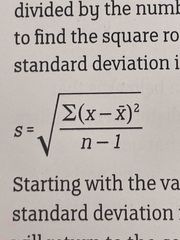![]()
![]()
![]()
Use LEFT and RIGHT arrow keys to navigate between flashcards;
Use UP and DOWN arrow keys to flip the card;
H to show hint;
A reads text to speech;
31 Cards in this Set
- Front
- Back
- 3rd side (hint)
|
null hypothesis |
no relationship between variables |
|
|
|
one tailed hypothesis |
directional- predicts a IV will have effect on the DV either positive or negative
e.g:adults will correctly recall more words than children |
|
|
|
two tailed hypothesis |
non directional- states there will be effect of IV on DV however does not state direction |
|
|
|
alternative hypothesis |
presents a relationship or difference between variables |
|
|
|
time sampling |
recording predetermined behaviours on specific time intervals e.g: every 5 secs |
|
|
|
event sampling |
recording predetermined behaviours on a checklist, writing down each time each behaviour occurs |
|
|
|
likert rating scale |
strongly agree| agree| neutral| disagree| strongly disagree |
|
|
|
semantic differential rating scale |
happy——————x—sad |
|
|
|
rating scale |
On a scale of 1-10 how much do u like music? (not at all) 1 2 3 4 5 6 7 8 9 10 (extremely) |
|
|
|
BPS ethical guidelines |
informed consent protection from harm debrief deception confidentiality ability to withdraw |
|
|
|
extraneous variables |
a variable you are not studying that could affect your results |
|
|
|
researcher bias |
bias to a particular research result due to researchers preconceived beliefs |
|
|
|
demand characteristics |
when’s participants change their behaviour as they think they figured out what the experiment is about |
|
|
|
areas of practical report |
abstract introduction method results discussion references appendices |
AIMRDRA |
|
|
what’s the abstract and appendices of report |
abstract- short summary of research appendices- extra information that wasn’t included in main body of report e.g:raw data,tables, photographs,sample questionnaires |
|
|
|
internal reliability |
consistency of results across items within the test |
|
|
|
external reliability |
can be generalised beyond this research |
|
|
|
inter rarer reliability |
seeing if different researchers gain the same results |
|
|
|
test retest reliability |
measures stability of research over time |
|
|
|
split half reliability |
measures the extent to which all parts of test contribute equally to what is being measured |
|
|
|
face validity |
whether the measure measures what its claimed to measure |
|
|
|
internal validity |
if research presents cause and effect relationship |
|
|
|
reliability |
consistency of results when repeated |
|
|
|
validity |
degree to which research measures what it sets out to measure |
|
|
|
external validity |
extender to which research results can be generalised to population |
|
|
|
variance |
difference between score and the mean |
|
|
|
how to measure variance |
- subtract each individual value from mean of group -square each result -add results -divide that by number of values minus 1 |
|
|
|
standard deviation |
square root of the variance measures how much sample data deviates from sample mean measure of dispersion |

|
|

define |
E= sum n= number of scores X=each score in data set X(with dash)=mean of data |
|
|
|
tyoe 1 error |
a false positive rejecting null hypothesis even if its true |
|
|
|
type 2 error |
a false negative accepting null hypothesis even if its wrong |
|

